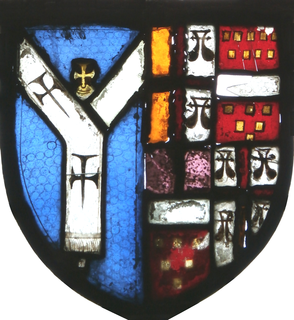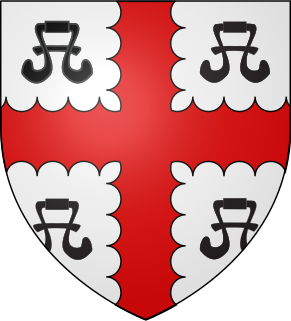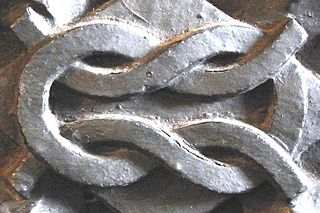
Thomas Bourchier was a medieval English cardinal, Archbishop of Canterbury, and Lord Chancellor of England.

Viscount Hereford is the oldest and only extant viscountcy in the Peerage of England, making the holder the Premier Viscount of England. The title was created in 1550 for Walter Devereux, 10th Baron Ferrers of Chartley.

Baron Berners is a barony created by writ in the Peerage of England.

John Bourchier, 2nd Baron Berners was an English soldier, statesman and translator.
John Bourchier may refer to:

William Bourchier, 1st Count of Eu, was an English knight created by King Henry V 1st Count of Eu, in Normandy.

John Bourchier, 1st Baron Berners, KG was an English peer.

Beningbrough Hall is a large Georgian mansion near the village of Beningbrough, North Yorkshire, England, and overlooks the River Ouse.
Bourchier is an English surname, from French Boursier, keeper of the purse. Bourchier is the Norman pronunciation.

Tawstock is a village, civil parish and former manor in North Devon in the English county of Devon, England. The parish is surrounded clockwise from the north by the parishes of Barnstaple, Bishop's Tawton, Atherington, Yarnscombe, Horwood, Lovacott and Newton Tracey and Fremington. In 2001 it had a population of 2,093. The estimated population in June 2019 was 2,372.

Henry Bourchier, 2nd Earl of Essex, 6th Baron Bourchier, 3rd Count of Eu and 2nd Viscount BourchierKGKBPC was an English soldier, peer and courtier at the courts of Henry VII and Henry VIII. He married Mary Say, by whom he had one daughter, Anne, who became his heir.

Robert Bourchier, 1st Baron Bourchier was Lord Chancellor of England, the first layman to hold the post.
John Bouchier may refer to:
Thomas Bourchier may refer to:
William Chadwick is the name of:
George Bourchier may refer to:

The Abbey of Saint Mary de Pratis, more commonly known as Leicester Abbey, was an Augustinian religious house in the city of Leicester, in the East Midlands of England. The abbey was founded in the 12th century by the Robert de Beaumont, 2nd Earl of Leicester, and grew to become the wealthiest religious establishment within Leicestershire. Through patronage and donations the abbey gained the advowsons of countless churches throughout England, and acquired a considerable amount of land, and several manorial lordships. Leicester Abbey also maintained a cell at Cockerham Priory, in Lancashire. The Abbey's prosperity was boosted through the passage of special privileges by both the English Kings and the Pope. These included an exemption from sending representatives to parliament and from paying tithe on certain land and livestock. Despite its privileges and sizeable landed estates, from the late 14th century the abbey began to suffer financially and was forced to lease out its estates. The worsening financial situation was exacerbated throughout the 15th century and early 16th century by a series of incompetent, corrupt and extravagant abbots. By 1535 the abbey's considerable income was exceeded by even more considerable debts.

The Bourchier knot is a variety of heraldic knot. It was used as a heraldic badge by the Bourchier family, whose earliest prominent ancestor in England was John de Bourchier, a Judge of the Common Pleas, seated at Stanstead Hall in the parish of Halstead, Essex. He was the father of Robert Bourchier, 1st Baron Bourchier (d.1349), Lord Chancellor of England. The various branches of his descendants held the titles Baron Bourchier, Count of Eu, Viscount Bourchier, Earl of Essex, Baron Berners, Baron FitzWarin and Earl of Bath. The knot should perhaps have been called the "FitzWarin knot" as according to Boutell (1864) the device was first used by the FitzWarin family, whose heir was the Bourchier family.
Henry Bourchier may refer to:
This page is based on this
Wikipedia article Text is available under the
CC BY-SA 4.0 license; additional terms may apply.
Images, videos and audio are available under their respective licenses.









